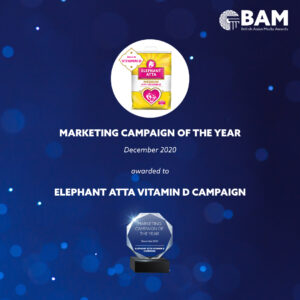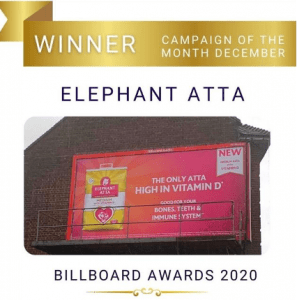
Elephant Atta Vitamin D Launch
BACKGROUND RESEARCH
It is a well-known fact that a significantly high percentage of South Asians living in the UK suffer from acute Vitamin D deficiency. Right from the NHS to independent medical research bodies like that of the University of Cambridge or the Medical Life Sciences wing of the University of Surrey have corroborated this fact. The deficiency leads to many health issues like fatigue, bone pain, muscle weakness and even depression in the ethnic populace of the country.
So, when Elephant Atta, UK’s premier South Asian flour brand with over 50% market share in the flour (atta) category conducted a research towards their New Product Development, the deficiency of Vitamin D in the ethnic community stood out as one of the biggest need gaps that the brand could address. The result was Elephant Atta Medium with Vitamin D, a product variant that delivers Vitamin D through the consumption of the everyday staple of ethnic South Asians – chapatti flour.
NPD LAUNCH
It is one thing to develop a relevant product for the target audience – the multicultural South Asian community – and quite another to effectively communicate it. In early 2020, HereandNow365 as a multicultural expert partnered with Elephant Atta through the launch of this new product targeted at the South Asian Mums.
The global pandemic created a scenario where there was a need for better immunity and support in the fight with COVID, as fatality was higher within certain ethnic communities and this was a major concern. And hence, the brand went ahead with the launch of the product which along with being a traditional atta would also help with the immunity among the multicultural South Asian communities.
The challenge was multi-fold. Not only did we need to establish the benefit of Vitamin D to a diverse community quickly,but we also needed to launch the product nationwide during the lockdown. This meant that one of the key legs towards promoting a new product, consumer sampling, was not an option. We had to ensure that the product found early adopters within our diverse, multicultural target group.
CHALLENGE
Chapatti Flour (Atta) is a commodity which has strong preferences among South Asian and ethnic communities as the texture of the Chapatti (Bread made from the Chapatti flour) can change with every variant of the flour. Research pointed out that most Mums from multicultural South Asian communities and Home chefs had a very strong perception of the flour they wanted to use for their chapatti and that conversion to a new variant was extremely difficult unless they were made to sample the product. The task at hand was to bring in a hook that will make South Asian Mums try the product without making them feel that their choice was compromised; but rather that it was the variant that their children would accept.
INSIGHTS
We spoke at length to our multicultural South Asian target group. The underlying theme that emerged was that South Asian Mums were the happiest when their children would eat the chapatti. The rationale for making that effort in a South Asian mother’s world was
a) She was doing something nutritional when she made fresh chapattis for her household especially her children
b) She was most satisfied when her children wanted to eat the chapattis proactively
However, there was an underlying thought that South Asian mothers secretly yearned for and didn’t express unless the conversation touched upon bigger issues of culture and belonging to a different set of values; where the norm was not the bread from the supermarket, but the humble Chapatti made every day traditionally. There was an unspoken pride in her South Asian, ethnic, and diverse culture and her biggest triumph was when her children would show a sense of belonging to that culture and not shy away from it. The communication needed to bridge this gap between the two worlds.
CAMPAIGN
Based on the above insights, we created a TV ad which would be watched by mothers on their favourite South Asian and ethnic daily soaps; where the likelihood of the entire family including kids, being together would be the highest, such as the Indian version of ‘Who Wants to be a Millionaire’ or IPL Matches which had a high following among South Asian kids.
The Ad showcased a multicultural Britain in a classroom setting and delivered the product benefits through a child who was proud of his culture and had the best of both worlds. His British education and his Mum’s cooking seamlessly blending into his persona. As the post campaign research proved, the product recall was high among the multicultural South Asian children who asked their Mums for their chapattis to be made from the Atta with Vitamin D. The mothers from multicultural ethnic backgrounds were proud to see an ad which they could relate to in their lives as most ads in this category border on the theatrical and Bollywood based fantasy execution. The recall was as high as 70% among the multicultural, ethnic South Asian target group.
This was aggressively supported by an influencer campaign that targeted young multicultural,South Asian parents online and recruited more than 40 digital influencers who would supplement the role of sampling and create a voice of approval for the product. Radio live reads and weather updates covered that trip to the local supermarket when purchase decisions were considered by these multicultural ethnic audiences. More than 100,000 Coupons through door drops were executed to incentivise purchase and for those who were out and about, an Outdoor campaign was rolled out in high density ethnic South Asian pockets throughout the UK.

RESULT
With an effective and relevant message for our ethnic South Asian target audience, and diverse and ethnic specialist mediums firing in synchrony, we successfully launched this one-of-a-kind product in spite of the lockdown. The biggest proof of the success of the launch being the stocks flying off the shelves in the supermarkets.
The sampling was unusually high for the category and some of the broadcasters received messages from diverse,ethnic audiences asking for the ad to be played more regularly; such was the appeal of the product.
Moreover, the campaign won the ‘Billboard Award of the Year’ and the BAM (British Asian Media) Awards for the Campaign of the Year for its effectiveness.

